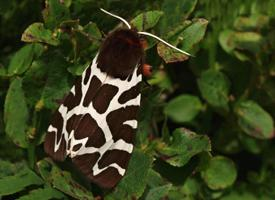
Greutăți și măsuri
| Lungimea anvergurii aripilor | de la 5 la 7 cm |
|---|
Descrierea animalului
The Garden Tiger Moth (Arctia caja) is a visually striking and fascinating species of moth belonging to the Erebidae family. This moth is widely recognized for its distinctive and vividly colored wings, which serve as a warning to predators about its potential unpalatability. Native to the temperate regions of Europe, North America, and Asia, the Garden Tiger Moth has adapted to a wide range of habitats, including gardens, meadows, woodlands, and grasslands, making it a common sight in many parts of its distribution range during the warmer months.Adult Garden Tiger Moths boast a wingspan of approximately 45 to 65 millimeters. The forewings are a rich brown or dark gray color, intricately patterned with a complex mosaic of black spots and lines. What truly sets this moth apart, however, are its hindwings, which are a vibrant orange or red, adorned with bold black spots. This stark contrast in colors is not just for show; it plays a crucial role in the moth's defense strategy against predators, signaling that it may be toxic or unpalatable.
The body of the Garden Tiger Moth is robust and furry, with a coloration that generally matches the darker tones of the forewings, providing excellent camouflage when the moth is at rest with its wings closed. The moth's antennae are feathery in males, which use them to detect pheromones released by females, and somewhat less feathery in females.
Garden Tiger Moths are nocturnal, and adults are most active during the night when they are out feeding on nectar from a variety of flowering plants. During the day, they tend to rest hidden among vegetation, relying on their camouflage to protect them from daytime predators.
The caterpillar stage of the Garden Tiger Moth, known as the "woolly bear," is equally distinctive. It is densely covered in long, black and brown hairs, which can cause irritation if handled. These hairs serve as a defense mechanism, deterring predators such as birds and small mammals. The woolly bear feeds on a wide variety of plants, including nettles, dock, and dandelions, making it a highly adaptable and resilient species.
The life cycle of the Garden Tiger Moth begins with the female laying eggs on the underside of host plant leaves. Once hatched, the caterpillars feed voraciously, growing rapidly before pupating in a cocoon hidden in the ground or among leaf litter. The moth emerges from the pupa the following year, continuing the cycle of life for this captivating species.
Conservation-wise, the Garden Tiger Moth has experienced declines in certain areas due to habitat loss, pesticide use, and changes in agricultural practices. However, it remains a common and widespread species in many parts of its range. Its presence in gardens and natural habitats serves as an indicator of a healthy, biodiverse environment.
In summary, the Garden Tiger Moth (Arctia caja) is a remarkable and beautiful moth, celebrated for its striking coloration and patterns. Its adaptability to different environments and the intriguing life cycle of its woolly bear caterpillar make it a fascinating subject of study for entomologists and a beloved sighting for nature enthusiasts.
Fotografii noi cu animale
Top 10 animale
- Diana monkey (Cercopithecus diana)
- Dolphin gull (Leucophaeus scoresbii)
- Galápagos tortoise (Geochelone nigra complex)
- Moustached guenon (Cercopithecus cephus)
- Japanese spider crab (Macrocheira kaempferi)
- Colossal squid (Mesonychoteuthis hamiltoni)
- Fox tapeworm (Echinococcus multilocularis)
- Stone loach (Barbatula barbatula)
- Japanese macaque (Macaca fuscata)
- Barbary macaque (Macaca sylvanus)